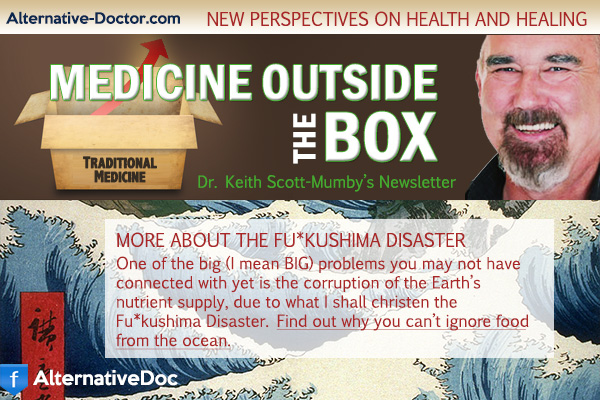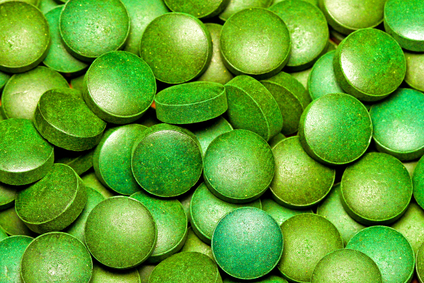One of the big (I mean BIG) problems you may not have connected with yet is the corruption of the Earth’s nutrient supply, due to what I shall christen the Fu*kushima Disaster.
Spirulina, krill oil, herrings (the “silver darlings” of history), plankton and our much-loved Quinton marine plasma are all facing possible oblivion. So far it’s looking worse than all the ecological damage done by Monsanto and the other biotech companies put together.
You can go organic and avoid the GMO and pesticide problem.
But you can’t ignore food from the ocean.
See, most of the world’s nutrients lie at the bottom of the sea. Forget the idea that the ocean is just a wastebasket, if you ever had such a thought.
Everything that ever lived, every nutrient, mineral and organic molecule ends up, sooner or later, in the mud on the floor of our oceans. The dinosaurs are all down there, except the small amount that went into the ecosystem cycle.
 Every living thing that dies anywhere ends up in the ocean, as their bodies decay and wash down streams and rivers, into the waiting seas. Does this scare you? My goodness, it should!
Every living thing that dies anywhere ends up in the ocean, as their bodies decay and wash down streams and rivers, into the waiting seas. Does this scare you? My goodness, it should!
Do not think of this as remote, inert mud, that’s miles down beneath the surface. Oh no! Nature is quicker than that. Everything on the ocean floor comes back into circulation, in massive and critical sites called ocean upwellings.
At these spots on our planet EVERYTHING is brought back to the surface…every algae, every dinosaur, every fish and sabre-toothed tiger that ever lived is stirred up and brought to the surface and an unbelievably rich nutrient soup. It’s what feeds the plankton!
The plankton feeds the krill, the fishes come next, then bigger fish, then mammals and whales and finally…US!
Homo not-very-sapiens (sapiens means wise). We are at the top of that food chain. But it’s not localized. It spreads round the world.
Here’s a picture of where upwellings tend to occur.

The coastal upwelling in the red regions is the result of deep oceanic currents colliding with sharp coastal shelves, forcing nutrient-rich cool water to the surface.
Over 90% of the world’s living biomass is contained in the oceans, yet only about 0.2% of marine production is harvested.
The Peruvian upwelling is a 300 x 300 mile area adjacent to the coast and is the most biologically productive coastal upwelling system on Earth. Carbon levels (an indicator of production) are tens of times higher than those of the next most productive upwelling region, the California current.
Notice that THE TWO TOP NUTRIENT UPWELLINGS ON EARTH ARE “DOWNSTREAM” FROM FUKUSHIMA.
Spirulina
So what about something like spirulina? You probably know it’s just about the oldest food on the planet.
Blue-green algae go back billions of years and predate all other life. In fact spirulina (like its sister superfood chlorella) is actually classed as cyanobacteria. It’s unique in that it has chlorophyll and uses the sun for energy. Just like plants do.
Ancient cultures like the Toltec – the precursors of the Aztec and the Maya – and the Kanembu who live by Lake Chad in Africa thrived on Spirulina. They often gathered the blue-green algae floating on the surface of nearby bodies of water, dried it under the sun and mixed it into their food.
This plant-like organism has survived on Earth for billions of years because it can thrive in very harsh conditions. Spirulina can grow in salt or fresh water and protects itself by packing in huge amounts of nutrients for sustenance when the environment is oppressive. 
The best part is that when you eat spirulina, these protections from a stressful environment are passed on to you.
Spirulina is 55-70 percent protein. Even better, it’s a complete protein because spirulina has all the so-called essential amino acids. Those are the ones your body needs every day but can’t make for itself. So you have to get them from food.
Note that, whatever you are being told by shady marketers or ignorant self-styled nutritionists (I call them Google-nutritionists, because that’s where they get their “information”), vegetarian foods like beans, wheat, soy and other plants are incomplete sources of protein. They don’t have all the essential amino acids.
Spirulina is also rich in vitamins A, B1, B2, B3, B6, B9, C, D, and E. it has the minerals you need like potassium, copper, calcium, chromium, iron, magnesium, manganese, phosphorous, selenium, sodium, and zinc.
I could go on and on. But the point is that this wonder-food and its potential to feed Mankind, could become compromised in the next few years, if it isn’t already too late.
What can I say? It’s back to the headline I used last week: Our world is changed forever and not for better (quoting a John Lennon song, did you spot that?)
Iodine
Since the last article, everyone has been asking about taking iodine and how much to take.
Lugol’s is best. You can buy it all over the Net. Buy several bottles NOW because you don’t know when it’s going to start being contaminated.
Dose: minimum 2 – 3 drops of Lugol’s a day. Lugol’s is elemental iodine (5 %) and potassium iodide (10%) with 85 % water. You can take 8 – 10 drops (about 50 mg but depends on the concentration of the Lugol’s and your dropper). It tastes metallic but is not poisonous at those doses, whatever your namby-pamby doctor says.
After a few months, you can lower the dose. Read David Brownstein’s book about iodine, if you haven’t already: Iodine: Why You Need It, Why You Can’t Live Without It.
Read about the powerful antibiotic effects of iodine. It’s one of Nature’s wonders.
“In 1945, a breakthrough occurred when J.D. Stone and Sir McFarland Burnet (who later went on to win a Nobel Prize for his Clonal Selection Theory) exposed mice to lethal effects of influenza viral mists. The lethal disease was prevented by putting iodine solution on mice snouts just prior to placing them in chambers containing influenza viruses.”
–Dr. David M. Derry MD, PhD
Iodine is just one of many simple yet potent natural antibiotics. An abundance of these natural powerful treatments can be found in my book “How To Survive In A World Without Antibiotics.”
Keep reading below to discover surprising and effective alternatives to antibiotics in the next section.
The Golden Age of Antibiotics is Over!
Modern antibiotics are not just failing big time; they are DANGEROUS. Antibiotics can be lethal in their own right.
Did you know that antibiotics are the most common cause of death from acute liver failure? (acute means sudden and unforeseen; as opposed to “chronic”, which everyone can see coming).
The truth, is statistics show that antibiotics are the single largest class of drugs that cause fatal liver damage.
Yes, antibiotics were the most common cause of death due to liver injury (45%). The next group, nervous system agents, were only 1/3rd as common (15%). That puts antibiotics way out on their own as deadly drugs.
Chief offenders are macrolides (erythromycin type), penicillins, clavulanic acid (Augmentin), tetracycline, and more.
I’m constantly amazed when I hear of colleagues prescribing erythromycin as a first line medicine for a sore throat. Don’t they know how toxic this stuff is?
It had a bad reputation when I was in med school in the 1960s. Doesn’t anybody pay attention? If it’s to be used at all, it’s in a life-threatening situation where penicillin’s and safer drugs have failed.
The bottom line is nobody should be thinking “antibiotics”. We should be thinking of “alternatives”. And here’s the joke: there are 1,000s of viable alternatives. Hundreds of them work as well as antibiotics.
The Golden Age of Antibiotics is over. Bacteria have won the war, hands down, and that’s the truth. We’re all out of ammunition! The cupboard is bare.
Well, not quite. There are, as I said, hundreds of healthy, safe and EFFECTIVE alternative modalities of treatment. You need to find out about them and learn NOW, not when somebody is in bed with life-threatening pneumonia (non-hospital pneumonia, which is the 4th most common cause of death in the UK; 6th commonest in the USA).
Click here to get the knowledge you need to stay safe and take care of your loved ones. Go here to learn what you need to know to SURVIVE IN A WORLD WITHOUT ANTIBIOTICS.
The post More About the Fukushima Disaster… appeared first on Alternative Doctor Dev Site.
